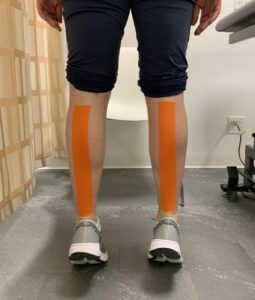
No doubt you have seen them. Brightly colored elastic tape on shoulders, calves, knees used by high-profile athletes on television. When an Olympic athlete uses them and supports them, then this will inevitably influence weekend warriors, patients and health practitioners to use them. But how useful are these? Does the scientific evidence support their use or is it merely cosmetic and marketing?
Let’s start with the history behind the taping technique. It was developed in the late 1970’s by a Japanese chiropractor, Dr. Kenzo Kase, who was interested optimizing the body’s natural healing process (#1). Whereas the classic white athletic tape was designed to restrict movement, Kinesio Tape (KT Tape) was flexible enough to allow normal range of motion yet purportedly strong enough to support muscles, joints, and ligaments. (#1) It is proposed that the tape stretches 120-140% of its original length with the ability to recoil, thus supporting motion rather than restricting motion. Other claims include alleviating pain and improving blood and lymphatic flow.
What does the research say?
A systematic review found that although KT Tape is widely used to treat musculoskeletal injuries, there is, unfortunately, little evidence of its superiority compared to sham taping and no taping at all. The authors hypothesized that the growing use of KT Tape is likely due to marketing campaigns. (#3)
Another review study concluded that KT Tape may have small beneficial effects on strength and active range of motion, but more research is needed. No evidence was found to support the improvement of pain or joint awareness in space (proprioception). (#2) So, with little evidence of its effectiveness, then why is it so popular among patients and athletes?
There is one important thing to consider: a perceived benefit cannot be discounted (#3/#4). You may have had your shoulder or ankle taped and thought “Hey, I have less pain and can move easier.” Great! Therein lies the power of belief. Did you know that in the area of chronic rotator cuff shoulder injuries, that 80% of these injuries do not require surgery and respond well to physiotherapy despite having an observable tear on radiology (#5)? The strongest predictor of surgery was not the size or location or continuing presence of the tear but patient expectations regarding the usefulness of physiotherapy. A patient’s failure of rehabilitation and decision to undergo surgery is influenced more by low expectations regarding the effectiveness of physical therapy than by symptoms or anatomic features of the tear.
So, is the clinical effectiveness of any modality (medications, surgery, exercise and taping) then entirely dependent on belief? Of course not. This does not mean that a shoulder strength and conditioning program has no physical effect on pain and the restoration of function. It merely highlights the importance of human belief (and on the flip side, unbelief) in any treatment intervention. It is so interesting that belief of taping’s effectiveness can overcome its lack of scientific validity and conversely, unbelief can also have the potential to overcome an intervention that has significant scientific validity.
Take Home Message
Current evidence does not support the use of KT tape. However, if you have found taping helpful in the management of current injuries, there is no perceived harm in its continued use. However, it should not be relied upon as your sole and ongoing treatment of choice especially if that nagging problem persists! And if you are genuinely interested in improving your outcomes, regardless of the modality, then a spirit of optimism will always contribute to better outcomes than pessimism.
References
- Kinesio Taping. (n.d.). What is Kinesio Tape? https://kinesiotaping.com/about/what-is-kinesio-tape/
- Williams, S., Whatman, C., Hume, P.A., & Sheerin, K. (2012). Kinesio Taping in Treatment and Prevention of Sports Injuries. Sports Med 42,153–164. https://doi.org/10.2165/11594960-000000000-00000
- Parreira, Pdo C., Costa, Lda C., Hespanhol, LC Jr., Lopes, AD., & Costa, LO. (2014). Current evidence does not support the use of Kinesio Taping in clinical practice: a systematic review. J Physiother, 60(1), 31-9. doi: 10.1016/j.jphys.2013.12.008.
- Mostafavifar, M., Wertz, J., & Borchers, J. 2012. A systematic review of the effectiveness of kinesio taping for musculoskeletal injury. Phys Sportsmed, 40(4):33-40. doi: 10.3810/psm.2012.11.1986.
- Dunn WR, Kuhn JE, Sanders R, An Q, Baumgarten KM, Bishop JY, Brophy RH, Carey JL, Harrell F, Holloway BG, Jones GL, Ma CB, Marx RG, McCarty EC, Poddar SK, Smith MV, Spencer EE, Vidal AF, Wolf BR, Wright RW; MOON Shoulder Group. 2013 Neer Award: predictors of failure of nonoperative treatment of chronic, symptomatic, full-thickness rotator cuff tears. J Shoulder Elbow Surg. 2016 Aug;25(8):1303-11. doi: 10.1016/j.jse.2016.04.030. PMID: 27422460.
A Collaboration between Katelyn Rennie and Albert Chan
